
Argyll and Bute is one of 32 unitary council areas in Scotland and a lieutenancy area. The current lord-lieutenant for Argyll and Bute is Jane Margaret MacLeod. The administrative centre for the council area is in Lochgilphead at Kilmory Castle, a 19th-century Gothic Revival building and estate. The current council leader is Robin Currie, a councillor for Kintyre and the Islands.

The Firth of Clyde is the mouth of the River Clyde. It is located on the west coast of Scotland and constitutes the deepest coastal waters in the British Isles. The firth is sheltered from the Atlantic Ocean by the Kintyre peninsula, which encloses the outer firth in Argyll and Ayrshire. The Kilbrannan Sound is a large arm of the Firth of Clyde, separating the Kintyre Peninsula from the Isle of Arran. Within the Firth of Clyde is another major island – the Isle of Bute. Given its strategic location at the entrance to the middle and upper Clyde, Bute played a vital naval military role during World War II.

Dunoon is the main town on the Cowal peninsula in the south of Argyll and Bute, Scotland. It is located on the western shore of the upper Firth of Clyde, to the south of the Holy Loch and to the north of Innellan. As well as forming part of the council area of Argyll and Bute, Dunoon also has its own community council. Dunoon was a burgh until 1976.

Cowal is a rugged peninsula in Argyll and Bute, on the west coast of Scotland. It is bounded on the west by Loch Fyne and on the east by Loch Long and the Firth of Clyde. The Kyles of Bute separate it from the Isle of Bute to the south.
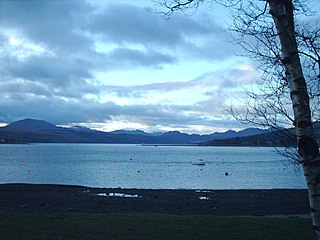
The Gare Loch or Gareloch is an open sea loch in Argyll and Bute, Scotland and bears a similar name to the village of Gairloch in the north west Highlands.

USS Casimir Pulaski (SSBN-633), a James Madison-class ballistic missile submarine, was the second ship of the United States Navy to be named for Casimir Pulaski (1745–1779), a Polish general who served in the American Revolutionary War.

Sandbank is a village on the Cowal peninsula in Argyll and Bute, Scotland. It is located 2.5 miles north of Dunoon on the coastal A815 or the inland A885 and sits on the southern shore of the Holy Loch, branching off the Firth of Clyde.

His Majesty's Naval Base, Clyde, primarily sited at Faslane on the Gare Loch, is one of three operating bases in the United Kingdom for the Royal Navy. It is the navy's headquarters in Scotland and is best known as the home of Britain's nuclear weapons, in the form of nuclear submarines armed with Trident missiles.
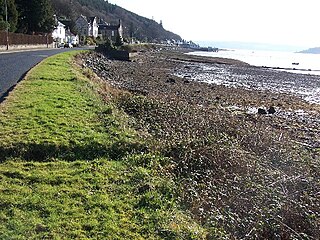
Kilmun is a linear settlement on the north shore of the Holy Loch, on the Cowal peninsula in Argyll and Bute, Scottish Highlands. It takes its name from the 7th-century monastic community founded by an Irish monk, St Munn. The ruin of a 12th-century church still stands beside the Kilmun Parish Church and Argyll Mausoleum.
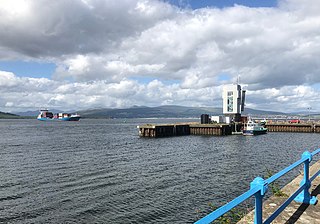
The Tail of the Bank is the name given to the anchorage in the upper Firth of Clyde immediately North of Greenock, between Inverclyde and Argyll and Bute. This area of the Firth gets its name from the deep water immediately to the west of the sandbank which marks the entrance to the navigable channel up the Estuary of the River Clyde.

Strone is a village on the Cowal peninsula in Argyll and Bute in the Scottish Highlands at the point where the north shore of the Holy Loch becomes the west shore of the Firth of Clyde. The village lies within the Loch Lomond and The Trossachs National Park.
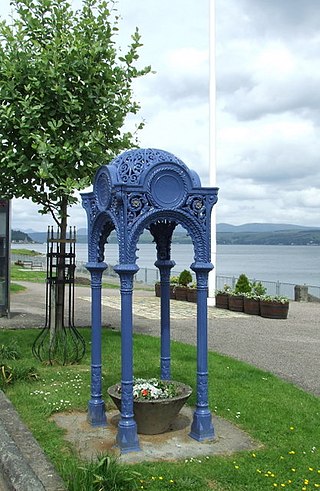
Kirn is a village in Argyll and Bute in the Scottish Highlands on the west shore of the Firth of Clyde on the Cowal peninsula. It now forms part of the continuous habitation between Dunoon and Hunters Quay, where the Holy Loch joins the Firth of Clyde. It originally had its own pier, with buildings designed by Harry Edward Clifford in 1895, and was a regular stop for the Clyde steamer services, bringing holidaymakers to the town, mostly from the Glasgow area.

Ardentinny is a small village on the western shore of Loch Long, 14 miles (23 km) north of Dunoon on the Cowal peninsula in Argyll and Bute, Scottish Highlands.

Ardnadam is a village on the Holy Loch on the Cowal peninsula, Argyll and Bute, Scotland. It is located northwest of Hunters Quay and east of Sandbank, and sits across the loch from Kilmun.
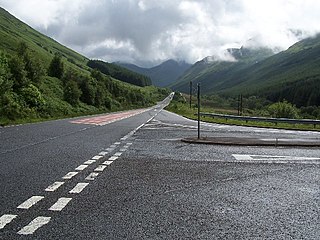
The A815 is a major road located in Argyll and Bute, Scotland. It runs for about 37 miles (60 km) from the A83, near Cairndow, in the north to Toward in the south. It passes beside three lochs, while its final stretch is along the Firth of Clyde.

Hunters Quay is a village, on the Cowal peninsula in Argyll and Bute, Scottish Highlands. Situated between Kirn to the south and Ardnadam to the north, Hunters Quay is the main base of Western Ferries, operating between Hunters Quay and McInroy's Point.
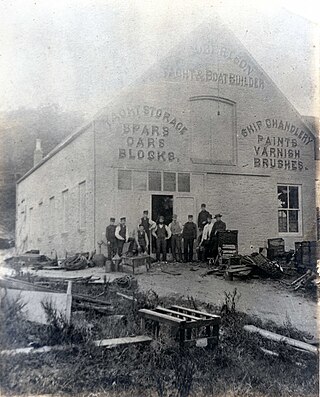
Alexander Robertson & Sons was a boatyard in Sandbank, Argyll and Bute, Scotland, from 1876 to 1980. The yard was located on the shore of the Holy Loch, not far from the Royal Clyde Yacht Club (RCYC) at Hunters Quay, in the building that is now the Royal Marine Hotel, which was the epicentre of early Clyde yachting. Alexander Robertson started repairing boats in a small workshop at Sandbank in 1876, and went on to become one of the foremost wooden boatbuilders on Scotland's River Clyde. The "golden years" of Robertson's yard were in the early 1900s, when it started building some of the first IYRU 12mR & 15mR racing yachts. Robertson's was well known for the quality of its workmanship and was chosen to build the first 15-metre yacht designed by William Fife III. More than 55 boats were built by Robertson's in preparation for the First World War and the yard remained busy even during the Great Depression in the 1930s as many wealthy businessmen developed a passion for yacht racing on the Clyde. During World War II the yard was devoted to Admiralty work, producing a wide range of large high-speed Fairmile Marine Motor Boats. After the war, the yard built the successful one-class Loch Longs and two 12-metre challengers for the America's Cup: Sceptre (1958) and Sovereign (1964). Due to difficult business conditions, the Robertson family sold the yard in 1965, and it was turned over to glass-reinforced plastic production work until it closed in 1980. During its 104-year history, Robertson's Yard built 482 numbered boats, many of which are still sailing today.
Submarine Squadron 14 , was a United States Navy submarine squadron.
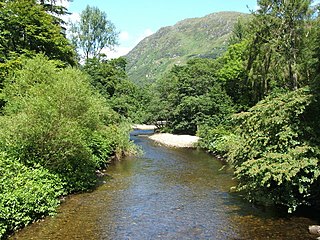
The River Eachaig is a river on the Cowal peninsula, Argyll and Bute, in western Scotland.
Invereck is a Category B listed building in Sandbank, near Dunoon, Argyll and Bute, Scotland. Dating to around 1886, it is located near the head of the Holy Loch.





















